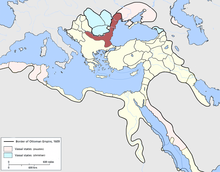| This article needs additional citations for verification. Please help improve this article by adding citations to reliable sources. Unsourced material may be challenged and removed. Find sources: "Silistra Eyalet" – news · newspapers · books · scholar · JSTOR (August 2011) (Learn how and when to remove this message) |
| Province of OchakivEyalet-i Silistra | |||||||||||||
|---|---|---|---|---|---|---|---|---|---|---|---|---|---|
| Eyalet of the Ottoman Empire | |||||||||||||
| 1593–1864 | |||||||||||||
 Flag
Flag | |||||||||||||
 The Silistra Eyalet in 1609 | |||||||||||||
| Capital | Silistra and Özi | ||||||||||||
| Area | |||||||||||||
| • Coordinates | 44°7′N 27°16′E / 44.117°N 27.267°E / 44.117; 27.267 | ||||||||||||
| • 1856 | 94,858 km (36,625 sq mi) | ||||||||||||
| History | |||||||||||||
| • Established | 1593 | ||||||||||||
| • Disestablished | 1864 | ||||||||||||
| |||||||||||||
The Eyalet of Silistra or Silistria (Ottoman Turkish: ایالت سیلیستره; Eyālet-i Silistre), later known as Özü Eyalet (Ottoman Turkish: ایالت اوزی; Eyālet-i Özi) meaning Province of Ochakiv was an eyalet of the Ottoman Empire along the Black Sea littoral and south bank of the Danube River in southeastern Europe. The fortress of Akkerman was under the eyalet's jurisdiction. Its reported area in the 19th century was 71,140 square kilometres (27,469 sq mi).
History

The Eyalet of Silistra was formed in 1593 as beylerbeylik of Özi (Ukrainian: Очаків, Očakiv) from territory of the former Principality of Karvuna, later Dobruja, Silistra was originally the Silistra Sanjak of Rumelia Eyalet.
It was named after Silistra, since its governor often resided in this Danubian fortress. Around 1599, it was expanded and raised to the level of an eyalet likely as a benefit to its first governor-general (beylerbeyi), the khan of Crimea. It was centered on the regions of Dobruja, Budjak (Ottoman Bessarabia), and Yedisan and included the towns of Varna, Kustendja (Constanța), Akkerman (Bilhorod-Dnistrovskyi), and Khadjibey (Odesa) with its capital at the fortresses of Silistra (now in Bulgaria) or Özi (now Ochakiv in Ukraine).
In the 17th century, Silistra Eyalet was expanded to the south and west to include most of modern Bulgaria and European Turkey including the towns of Adrianople (Edirne), Filibe (Plovdiv), and Vidin. In the late 17th and early 18th centuries, a series of Russo-Turkish Wars truncated the eyalet in the east with Russia eventually annexing all of Yedisan and Budjak to the Danube by 1812.
Edirne Eyalet was constituted from south of Silistra Eyalet in 1830. With Ottoman administrative reforms of 1864 the Silistra Eyalet was reconstituted as the Danube Vilayet.
Administrative division
Evliya Çelebi mentioned in his book (Seyahatnâme) that the Silistra or Özi Eyalet had ten sanjaks:
- Niğbolu Sanjak (Nikopol)
- Çirmen Sanjak (Ormenio)
- Vize Sanjak (Vize)
- Kırk Kilise Sanjak (Kırklareli)
- Bender Sanjak (Bender)
- Akkerman Sanjak (Bilhorod-Dnistrovskyi)
- Özi-Kale Sanjak (Ochakiv)
- Kılburun Sanjak (Kinburn)
- Doğan Sanjak (Beryslav)
- Silistre Sanjak (Silistra)
According to Sancak Tevcih Defteri, eyalet consisted of eight sanjaks between 1700 and 1730 as follows:
- Sanjak of Özi (Paşa Sancağı, Dnieper), centered at Özi-Kale (Ochakiv)
- Sanjak of Silistre (Silistra)
- Sanjak of Vidin (Vidin)
- Sanjak of Niğbolu (Nikopol)
- Sanjak of Kırk Kilise (Kırklareli)
- Sanjak of Çirmen (Ormenio)
- Sanjak of Vize (Vize)
- Sanjak of Tağan Geçidi (Beryslav) (until 1699)
Sanjaks in the early 19th century:
- Sanjak of Niğbolu
- Sanjak of Çirmen (after 1829, its capital was Edirne)
- Sanjak of Vize
- Sanjak of Kırk Kilise
- Sanjak of Akkerman, which was only a military command in Bilhorod (Akkerman) in the Budzhak
- Sanjak of Vidin
Beylerbeys
- 1615? - ? Iskender Pasha
- 1621–1623 Khan Temir
- 1631? - Late Spring 1632 Abaza Mehmed Pasha
- Late Spring 1632 - ? Murtaza Pasha
- c.1657 Melek Ahmed Pasha
- c.1683 Mustafa Pasha
References
- John Macgregor (1850). Commercial statistics: A digest of the productive resources, commercial legislation, customs tariffs, of all nations. Including all British commercial treaties with foreign states. Whittaker and co. p. 12. Retrieved 2013-06-02.
- Thomas Baldwin (of Philadelphia.) (1856). Lippincott's Pronouncing Gazetteer: A Complete Pronouncing Gazetteer Or Geographical Dictionary of the World ... J.B. Lippincott. p. 1968. Retrieved 2013-06-02.
- Charles Knight (1867). The English Cyclopaedia: Geography. Bradbury, Evans. p. 111. Retrieved 2013-06-02.
- ^ "Some Provinces of the Ottoman Empire". Geonames.de. Retrieved 25 February 2013.
- Conrad Malte-Brun; Adriano Balbi (1842). System of universal geography, founded on the works of Malte-Burn and Balbi... Adam and Charles Black. p. 607. Retrieved 2013-06-02.
- The Popular encyclopedia: or, conversations lexicon. Blackie. 1862. p. 698. Retrieved 2013-06-02.
- Nejat Göyünç, Osmanlı Devleti'nde Tașra Teșkilâtı (Tanzimat'a Kadar), Osmanlı, Cilt 6: Teșkilât, Yeni Türkiye Yayınları, Ankara, 1999, ISBN 975-6782-09-9, p. 78. (in Turkish)
- Evliya Çelebi; Joseph von Hammer-Purgstall (1834). Narrative of Travels in Europe, Asia, and Africa in the Seventeenth Century. Oriental Translation Fund. p. 92. Retrieved 2024-12-08.
- Orhan Kılıç, XVII. Yüzyılın İlk Yarısında Osmanlı Devleti'nin Eyalet ve Sancak Teșkilatlanması, Osmanlı, Cilt 6: Teșkilât, Yeni Türkiye Yayınları, Ankara, 1999, ISBN 975-6782-09-9, pp. 92-93. (in Turkish)
- George Long (1843). The Penny Cyclopædia of the Society for the Diffusion of Useful Knowledge: v. 1-27. C. Knight. p. 393. Retrieved 2013-06-02.
- ^ Kołodziejczyk 2011, p. 141.
- Kołodziejczyk 2011, p. 171.
Bibliography
- Kołodziejczyk, Dariusz (2011). The Crimean Khanate and Poland-Lithuania: International Diplomacy on the European Periphery (15th-18th Century). A Study of Peace Treaties Followed by Annotated Documents. Leiden: Brill. ISBN 9789004191907. Archived from the original on 2017-06-30. Retrieved 2016-01-21.
| Administrative divisions of the Ottoman Empire | |||||||||||||||||
|---|---|---|---|---|---|---|---|---|---|---|---|---|---|---|---|---|---|
| |||||||||||||||||
| |||||||||||||||||
- States and territories established in 1593
- States and territories disestablished in 1864
- Eyalets of the Ottoman Empire in Europe
- Ottoman period in the history of Bulgaria
- Ottoman period in Romania
- Ottoman period in Moldova
- Ottoman period in Ukraine
- History of Silistra
- States and territories established in 1599
- 1593 establishments in the Ottoman Empire
- 1864 disestablishments in the Ottoman Empire